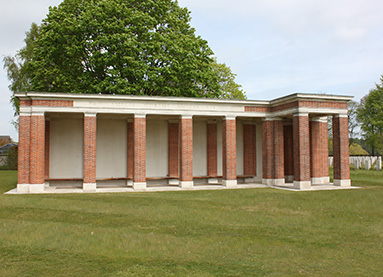Groesbeek Memorial
During the Second World War, many thousands of men and women from all countries of the British Commonwealth and Empire lost their lives in trying to repel the German invasion of the Netherlands and Belgium in 1940. In the ensuing struggle to liberate the occupied countries, some 11,000 of these have their graves in Belgium and nearly 20,000 lie in the Netherlands.
There are 1,068 who have no known grave. Of these, 103 are Canadians. The Groesbeek Memorial stands in Groesbeek Canadian War Cemetery about ten kilometres southeast of the Dutch town of Nijmegen. It commemorates, by name, those members of the Commonwealth land forces who died during the campaign in Northwest Europe between the time of crossing the Seine at the end of August 1944 and the end of the war in Europe.
The Memorial consists of twin colonnaded buildings, which face each other across the surfed forecourt of the Groesbeek Canadian War Cemetery, between the entrance and the Stone of Remembrance. The names of the men commemorated are inscribed in panels of Portland stone built into the rear walls. Within each building are inscribed the words:
"THESE WALLS BEAR THE NAMES OF THE SOLDIERS OF THE BRITISH COMMONWEALTH AND EMPIRE WHO FELL IN THE ADVANCE FROM THE RIVER SEINE THROUGH THE LOW COUNTRIES AND INTO GERMANY BUT TO WHOM THE FORTUNE OF WAR DENIED A KNOWN AND HONOURED GRAVE AUGUST 1944 - 5TH MAY 1945"
The Advance to Belgium and Holland, 1944
The Allied victory in Normandy in the summer of 1944 was followed by a rapid pursuit of the disorganized German armies across Northern France and into Belgium. The Second British Army swept forward on the left flank of General Sir Bernard Montgomery's 21st Army Group to liberate Antwerp on September 3. At the same time, the First Canadian Army, commanded by General H.D.G. Crerar, was engaged in clearing the coastal belt, opening Channel ports to much-needed Allied supply ships and overrunning the launching sites from which the enemy had been bombarding English cities with the destructive V-bombs.
In bitter fighting in Belgium and southwestern Holland, the Canadians drove the Germans back from the Scheldt estuary, to make the great port of Antwerp accessible to Allied shipping. During the winter of 1944-45, the Canadian Army held a line of more than 322 kilometres, extending from near the German frontier south of Nijmegen, along the Maas River and through the Dutch islands to Dunkirk on the Channel coast.
This static period ended in February 1945 with the opening of the Allied offensive to drive the Germans back across the Rhine. In one of the most decisive Rhineland battles, the First Canadian Army broke through the strong defences of the Siegfried Line in the Reichswald Forest south of Nijmegen. The 21st Army Group attacked over the Rhine on March 23, and from then on events moved swiftly. While American armies encircled the vital industrial area of the Ruhr valley and pushed eastward, the Canadian Army cleared the Netherlands and joined with British forces in a drive northeastward to the Baltic. Fighting ended on May 5, followed by the formal surrender of the German armies in Northwest Europe two days later.
Directions
Groesbeek is located 10 kilometres south east of the town of Nijmegen close to the German frontier. The Groesbeek Memorial stands in Groesbeek Canadian War Cemetery which is 3 kilometres north of the village and 1.5 kilometres east of the main road to Nijmegen. On leaving the A73 motorway at the junction Overasselt-Mook-Groesbeek, follow directions to Mook. Follow direction signs towards Mook War cemetery. After passing Mook War cemetery, continue to the village of Groesbeek to a roundabout. Turn left at the roundabout onto Dorpstraat passing through Groesbeek. The road name then changes to Molenweg. A Commonwealth War Graves Commission direction sign indicates the right hand turning from Molenweg onto the Zeven Heuvelenweg. The Groesbeek Canadian War Cemetery lies 1 kilometre after entering this road on the right hand side of the road. The memorial stands within the cemetery.
- Date modified:

